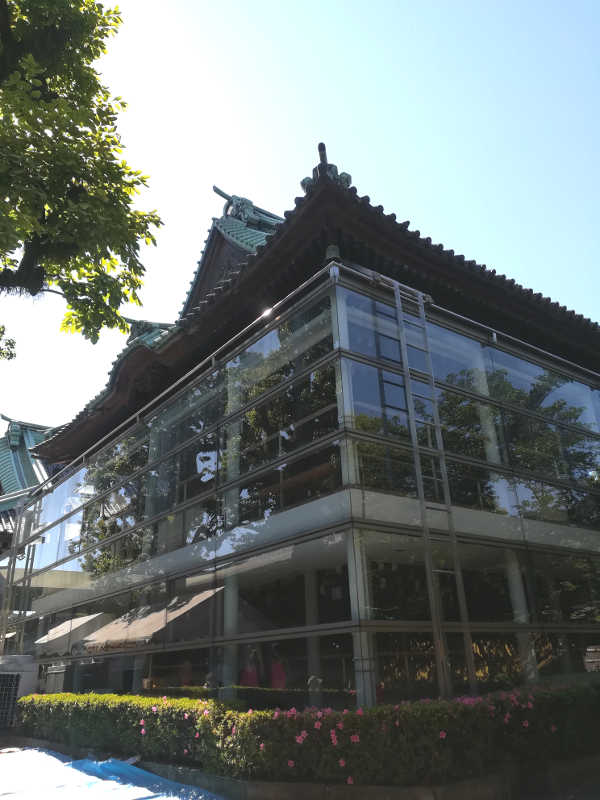I am YOSAKU in charge of the outskirts of Tokyo. This time, other members and I visited Shibamata Taishakuten, Tora-san Museum and more. We gathered near the Tora-san statue in front of Shibamata Station.

Shibamata station 
The slope from the platform to the exit in Shibamata station

We passed under the billboard of the approach and headed for Shibamata Taishakuten Temple. There are many traditional shops and restaurants on both sides of the approach. You can eat and walk along the approach. I bought Toraya’s Yaki-kusadango: a rice dumpling flavored with mugwort and soy sauce, covered by seaweed.at the shopfront and ate it. It was soft and very tasty.

The billboard of the approach to Taishakuten 
The approach to Taishakuten Temple

Toraya shop 
Yaki-kusadango
We walked for a few hundred meters to the end of the approach and found the entrance gate of Taishakuten Temple.

Taishakuen Teimple is famous for the elaborated wood carving. A wheelchair user is not allowed to get into the wood carving galley in order to preserve the wooden corridors of the temple, but he/she can see the wood carving where it is covered by glass walls.


We went out from the temple and turned left, went straight and turned left at the first corner, went straight along the street and found the entrance of Yamamoto-Tei which has a Japanese garden. You can walk through inside of the Yamamoto-Tei grounds and use a restroom with wheelchair access at free of charge.

The entrance of Yamamoto-Tei 
Inside the Yamamoto-Tei grounds
After walking through and getting out from the gate of Yamamoto-Tei, you can find the map to Tora-san Museum in front of you. For a wheel chair user, turn right and then turn left at the first corner, and climb a gentle slope up to the entrance of Tora-san Museum.

Tora-san Museum exhibits the part of movie sets of Otoko wa tsurai yo, (It’s tough being a man), movie props, all of 49 movie posters, and so on. Admission for Tora-san Museum and Yamada Yoji Museum is free for physical disability certificate holders and an attendant. The admission fee for adults for both Museums is 500 yen.

Yamada Yoji Museum introduces his various film works. He is the movie director of Otoko wa tsurai yo (It’s tough being a man)

After Yamada Yoji Museum, we took a walk and went to Yagiri no watashi wharf. By the way, a wheelchair user is not permitted on a ferry boat.

Edogawa riverbank 
Yagiri no watashi whalf
A Brief Accessibility Review from YUKORIN
Wheelchair users will be able to enjoy visiting Shibamata if they were just there to take a walk.
The approach from Shibamata Station to Shibamata Taishakuten Temple is flat. When this approach is not crowded with people, you can enjoy a retro ambiance of the town in a relaxing state of mind. However, there are stairs in Shibamata Taishakuten Temple. I felt sorry I could not admire the famous wood carvings and the openwork designs inside the temple. Instead of the inside, wheelchair users are able to take a look at wood carvings on the gates and the outside walls of the temple while walking around the buildings. There is a multipurpose restroom near the entrance gate where I found it small and not easy to use for a wheelchair user. On the other hand, a multipurpose restroom located at the Yamamoto-Tei grounds is clean and well-equipped. Although Yamamoto-Tei is located very near Tora-san Museum, there are stairs between them. Therefore, wheelchair users have to make a detour to visit Tora-san Museum from Yamamoto-Tei and then take an elevator near the museum entrance. While the routes inside Tora-san Museum and Yamada Yoji Museum are somewhat narrow, I could enjoy watching exhibits in both museums. But I sense that equipment of the multipurpose restrooms at both museums were a bit old-style. By the way, it seems impossible for wheelchair users to take Yagiri-no-watashi boats.
